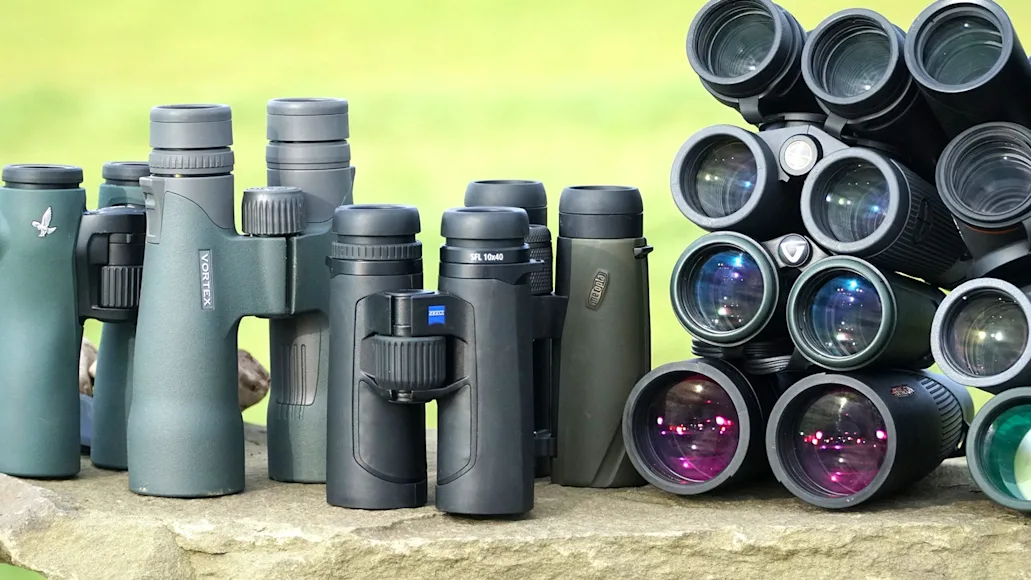We may earn revenue from the products available on this page and participate in affiliate programs. Learn more
Every hunter needs a good binocular. But not every hunter needs a great one, and the difference between good and great seems to get slimmer every year. Having tested binoculars for going on a couple decades now, I’m perennially shocked by how good mid-priced models have become—to the point where the average hunter has to strain himself to see the difference between the very best and really good ones that cost half as much, or less. That’s great news for all of us.
But there is a difference between good and great. If you’re someone who’ll sit behind your glass for half a day trying tease antlers from a sea of sagebrush or count tines at 1,000 yards, you’ll want to know which ones are truly top-shelf. If you’re on a budget, however, or you hunt mostly mix-woods whitetails, for example, really good might be more than good enough for your needs.
The question is, which is which? I spent a several weeks putting the latest full-size hunting binoculars through the wringer, including subjecting every model to a brutal weather-resistance test, to identify the very best binoculars of 2023, as well as the really good ones that most hunters can afford. So, which of the latest hunting binoculars is just right for you? Here’s the lowdown.
Editor’s Pick: Zeiss SFL 10×40
Best Value: Nikon Monarch M7 10×42
Best at Any Price: Swarovski NL Pure 10×42
Best for About a Grand: Meopta MeoPro Air 10×42
Best Low-Light: Vortex Razor UHD 10×50
The Rest of the Best
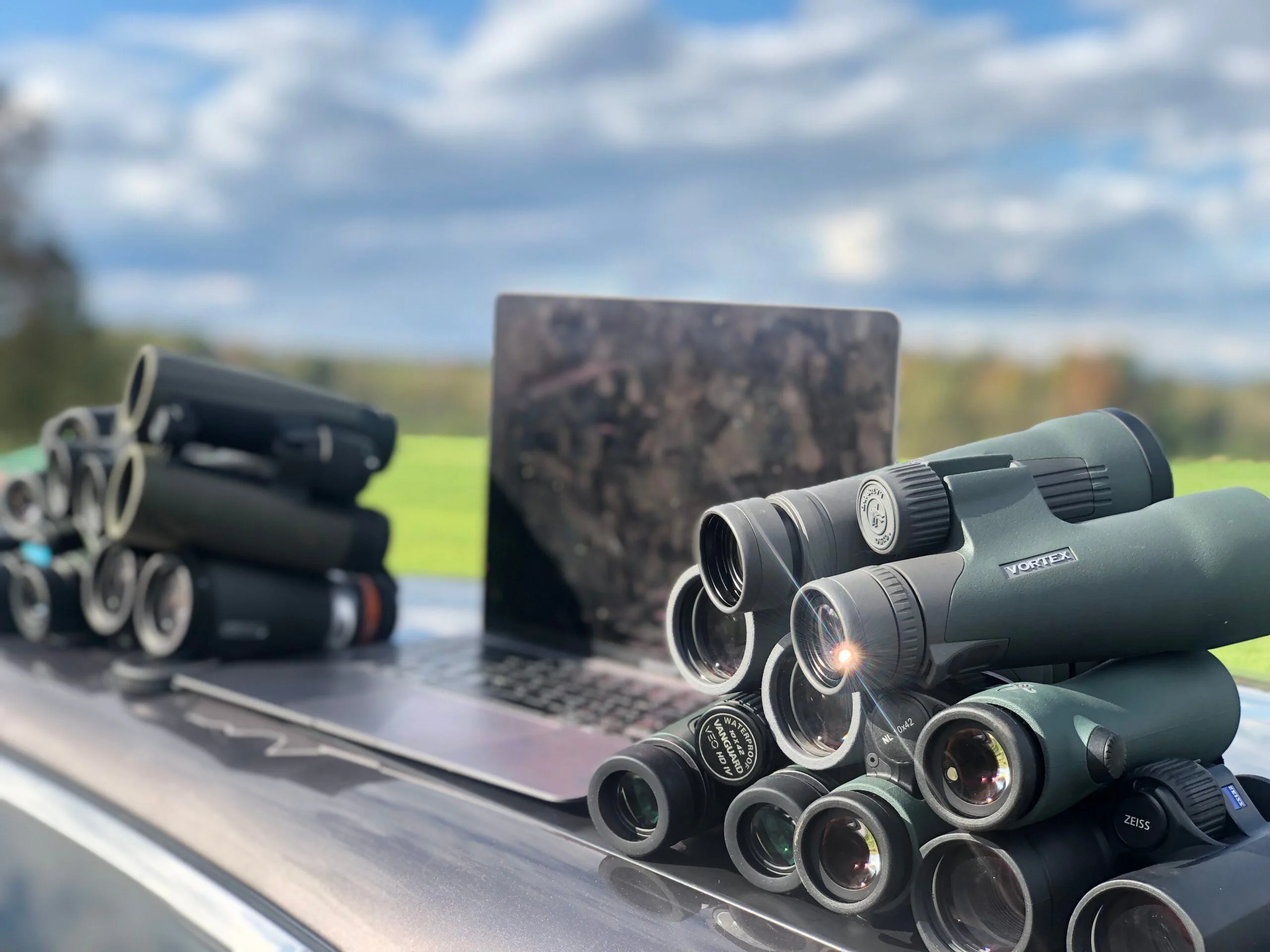
Editor’s Pick: Zeiss SFL 10×40
Why It Made the Cut: Ounce for ounce, this wonderfully lightweight binocular may be the best there is. Period.
Total Score: 93.5
Specs
Magnification: 10x
Objective Lens Diameter: 40mm
Exit Pupil: 4.0mm
FOV: 345’ @ 1,000 yards
Size: 5.7 x 4.5 inches
Weight: 22.6 ounces
Price: $1,550
Pros
The lightest, most compact full-size binocular in the test
Absolutely first-rate optics
Premium build quality
Very fairly priced for what you get
Cons
Not the best low-light performance, with its comparatively small exit pupil
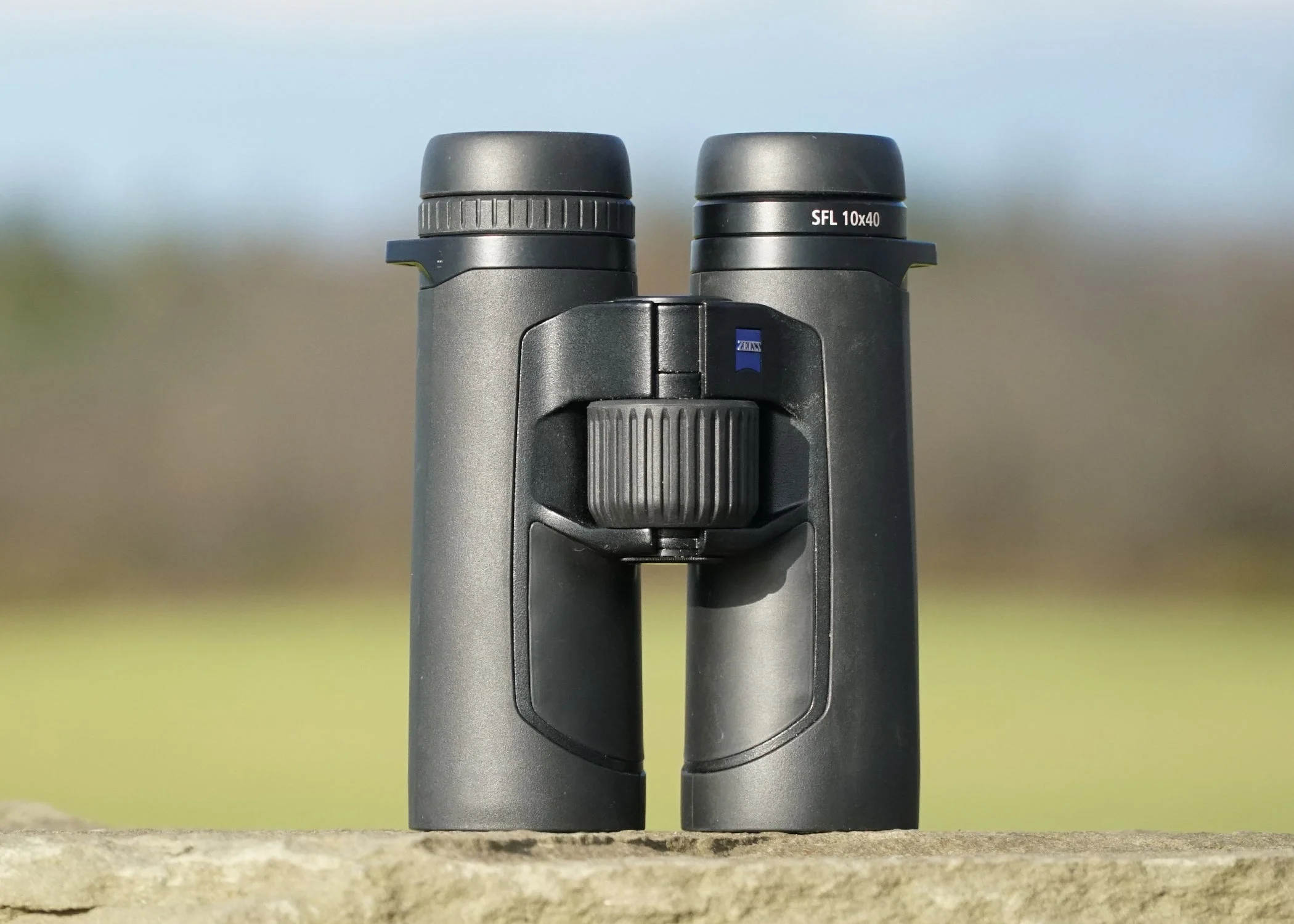
Zeiss’s SFL 10×40 came out last year and remains so superior to any new-for-2023 binocular I tested that there wasn’t a minute’s hesitation in giving it this year’s Editor’s Pick Award for best overall binocular. It’s rare to see something truly innovative or game-changing in this field. Binocular manufacturers can’t come out with a new caliber or make their product modular. A binocular is pretty much a binocular. But every once in a while, a company finds a new way to make the same old thing much better—and that is what Zeiss has done with the SFL 10×40.
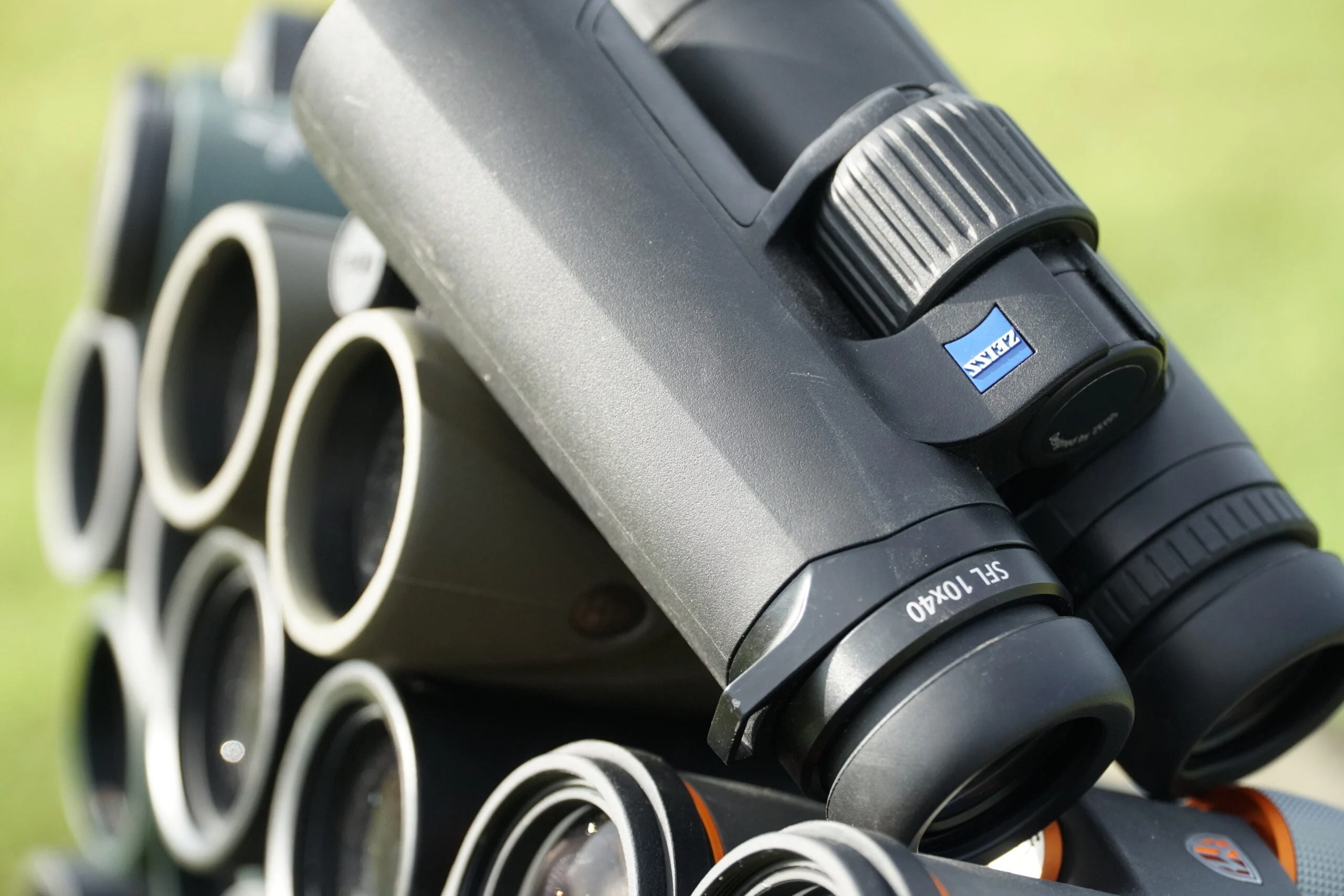
With any high-end binocular like this, you expect the resolution to be fine and image quality stunning, and both are with the SFL 10×40. (It scored barely behind the Swarovski in these categories, which is saying something.) You expect excellent build quality, ergonomics, and weather resistance. Check, check, check. But what makes the SFL 10×40 so innovative is what it lacks—namely, size and weight. By using an ultralight frame and a groundbreaking design that places thinner lenses closer together, Zeiss has delivered all of the qualities above in a lighter, more compact package. At just 22.6 ounces, with its big, smooth focus wheel and beautiful, bright image, the SFL 10×40 makes glassing a pleasure—and it lightens your burden in the bargain.
Because of its smaller exit pupil, the SFL 10×40 scored well but not at the very top in low-light performance. In every other category, it was right there with the best. In weather-resistance, it was the best, notching a perfect score. Any binocular that can do that, given our brutal test, can handle the absolute worst conditions and then some. Still—and you might be surprised here—what really secured the Editor’s Pick Award for the SFL 10×40 was the price. I know, $1,500-plus isn’t chump change for a binocular. But that’s less than half the cost of its closest competitor. The truth is that for such an outstanding binocular, $1,550 is kind of a bargain. Ounce-for-ounce and dollar-for-dollar, the Zeiss SFL 10×40 is as good as it gets.
Best Value: Nikon Monarch M7 10×42
Why It Made the Cut: It’s a whole lot of binocular for the money, and built to last too.
Total Score: 85.5
Test Model Specs
Magnification: 10x
Objective Lens Diameter: 42mm
Exit Pupil: 4.2mm
FOV: 362’ @ 1,000 yards
Size: 5.6 x 5.1 inches
Weight: 24 ounces
Price: $500
Pros
Compact and lightweight
Built tough
Impressive weather resistance
Solid optics
Locking diopter
Cons
Not the best low-light performance
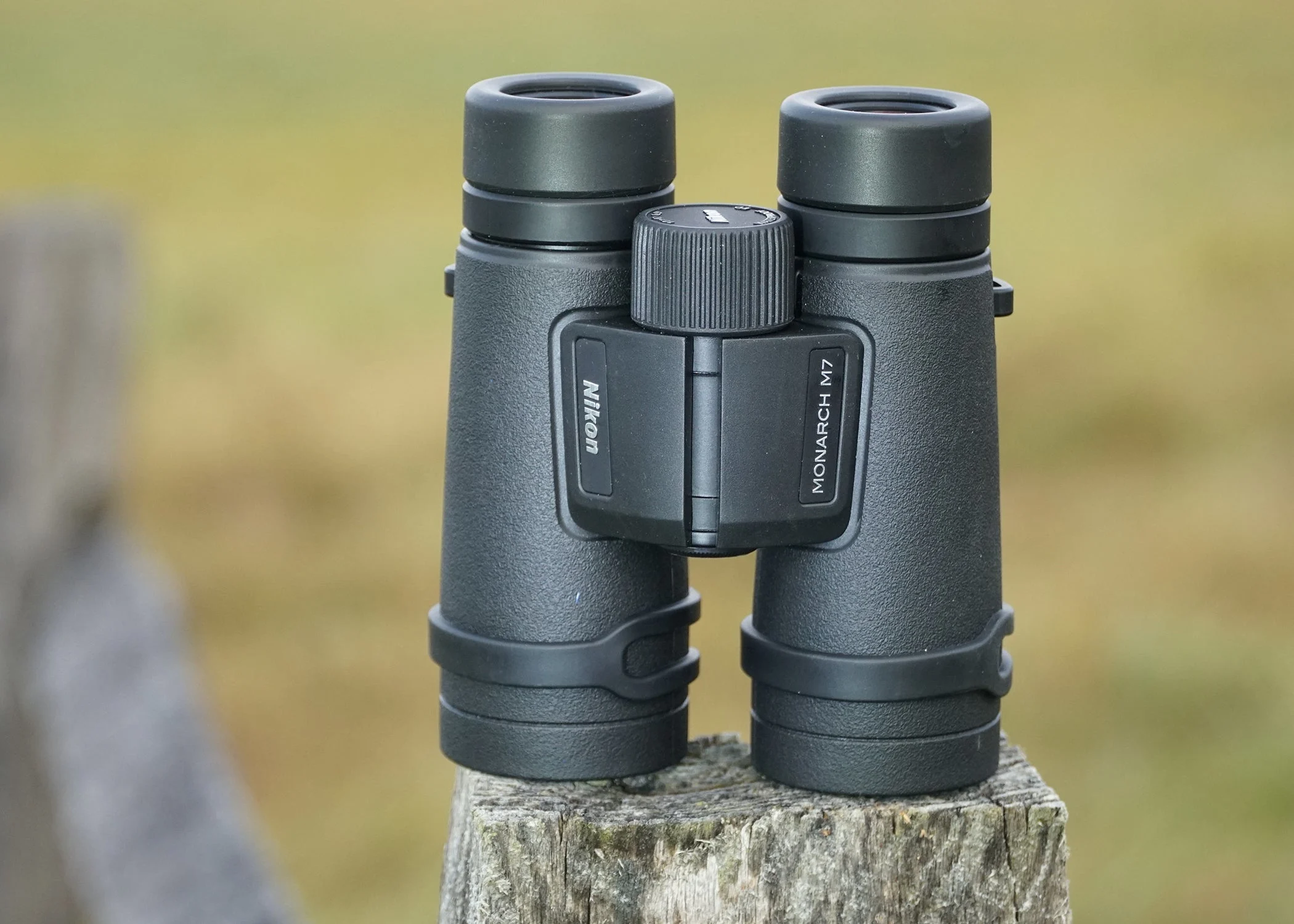
The Monarch M7 is new for 2023 and the latest in Nikon’s popular and rugged Monarch line. Like so many models with the Monarch name, the M7 exudes toughness; you put it in your hands and know instantly that you can hunt hard with the thing, thanks to its obvious build quality and thick rubber armoring. What you can’t tell instantly but was born out in the weather-resistance testing is that the optics themselves are just as rugged and reliable. Only one binocular did better in our brutal test, and only by half a point—and that binocular (the Zeiss above) costs about three times as much.
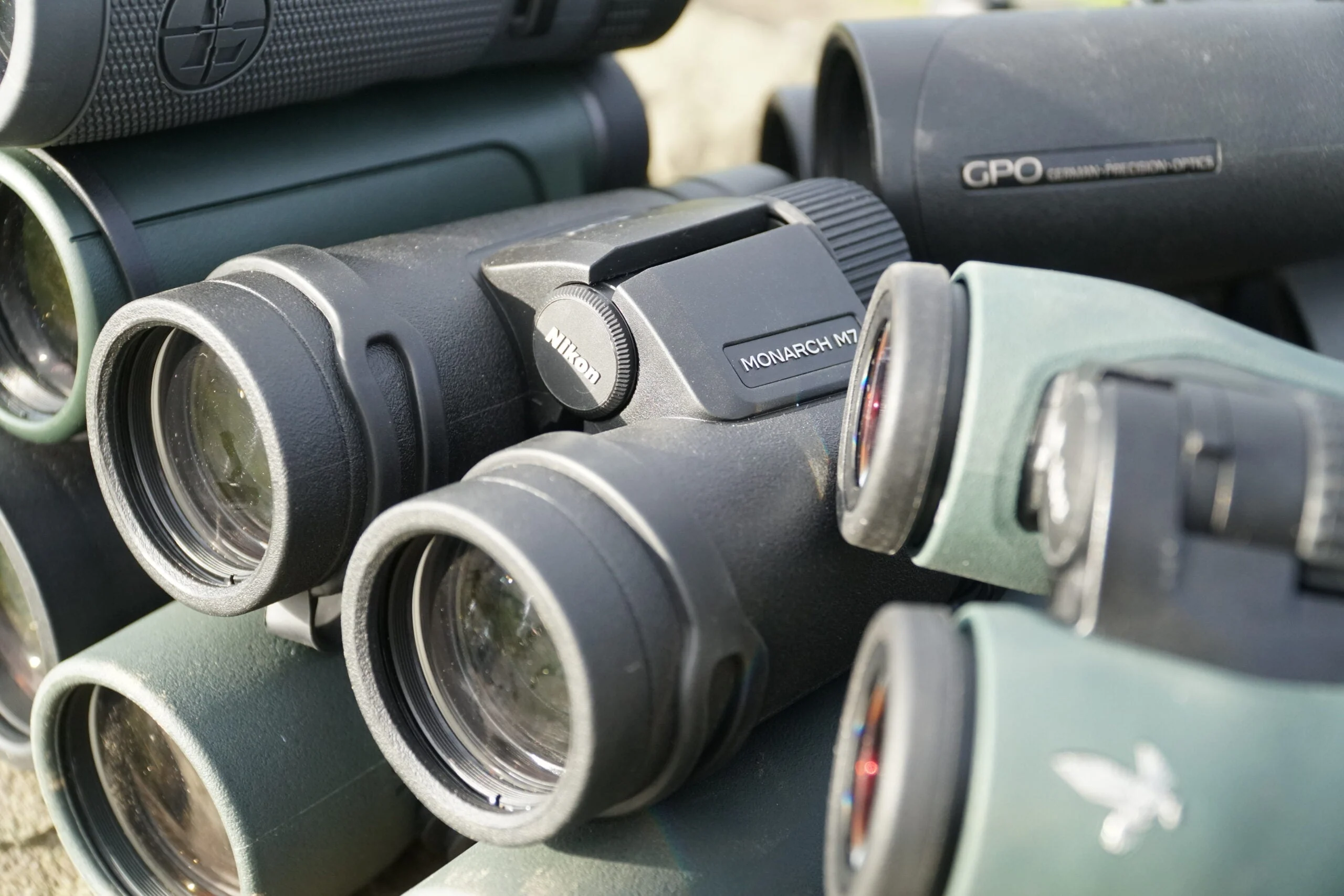
The M7’s ED glass delivered solid optical performance. Resolution and image quality was a step below the top-end glass, with some noticeable stray light, but both were still quite good. What hurt the M7 most was low-light performance, which was squarely middle of the road. The M7 got a nearly perfect score for handling; it fits nicely in your hands and feel good there, too, with it’s tacky rubber coating. The locking diopter is just what it should be, and although it’s a small thing, the objective lens caps, in terms of actually staying on the binocular, are as good as any and better than most. Where the M7 really shines, though, is value. For $500, you get a lightweight, compact full-size binocular that will hunt has hard as you do and deliver solid optical performance all the while. You can’t ask for much more than that.
Best at Any Price: Swarovski NL Pure 10×42
Why It Made the Cut: The NL Pure’s optical performance is otherworldly. The best. Period.
Total Score: 91.5
Test Model Specs
Magnification: 10x
Objective Lens Diameter: 42mm
Exit Pupil: 4.2mm
FOV: 399’ @ 1,000 yards
Size: 6.2 x 5.1 inches
Width: 5.1 inches
Weight: 30 ounces
Price: $3,743
Pros
Perfect scores in resolution and image quality
Unique styling and feel
Excellent low-light performance
Cons
Damned expensive
Not especially weather-resistant
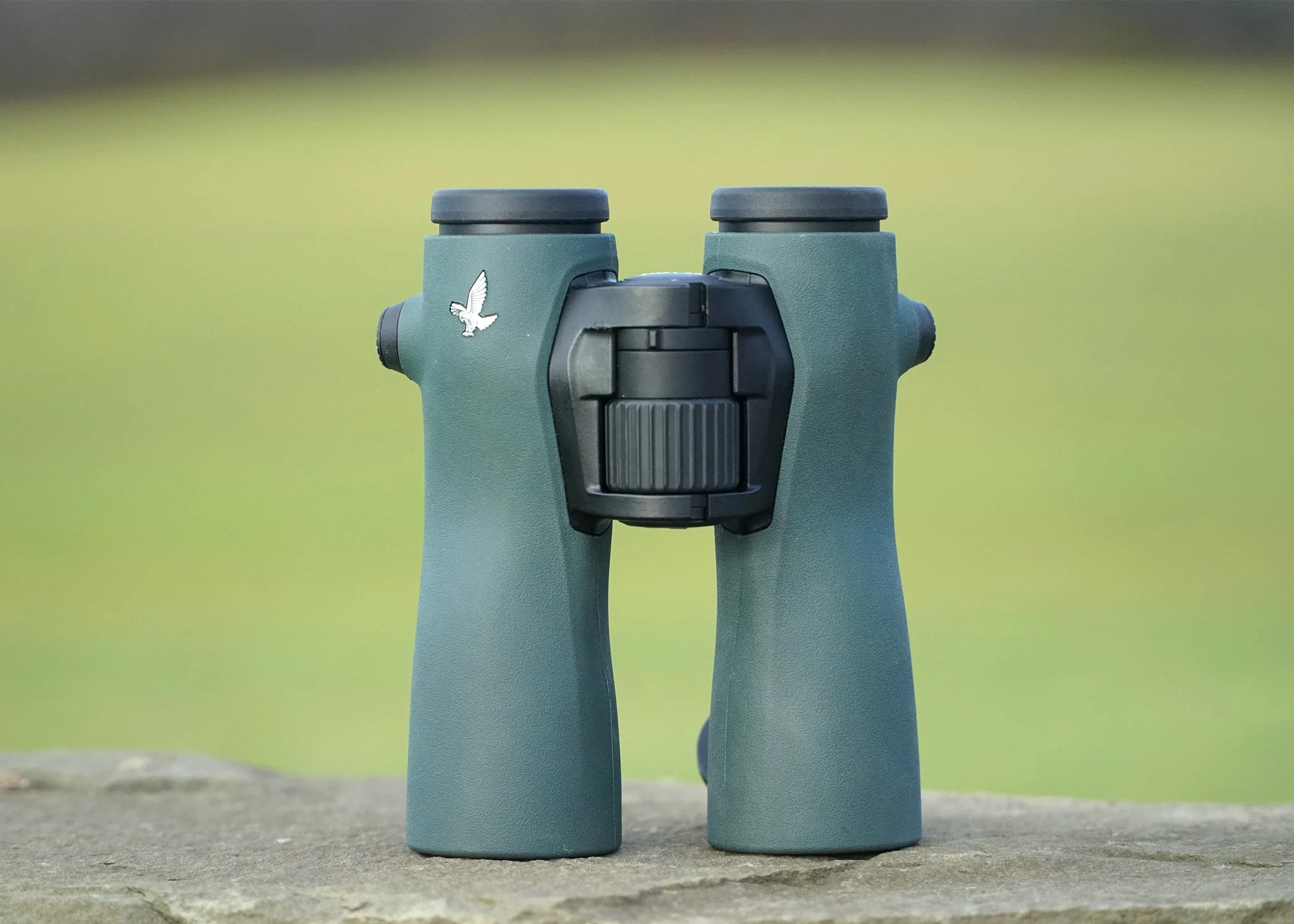
It’s true that the gap between good and great binoculars is closing. But a few still stand totally apart. The Swarovski NL Pure was the only binocular in the test to notch perfect scores in resolution and image quality, but it’s not enough to say its optical performance is the best or even perfect. It’s something more like a revelation. You look through this binocular and say “Wow!”—repeatedly.
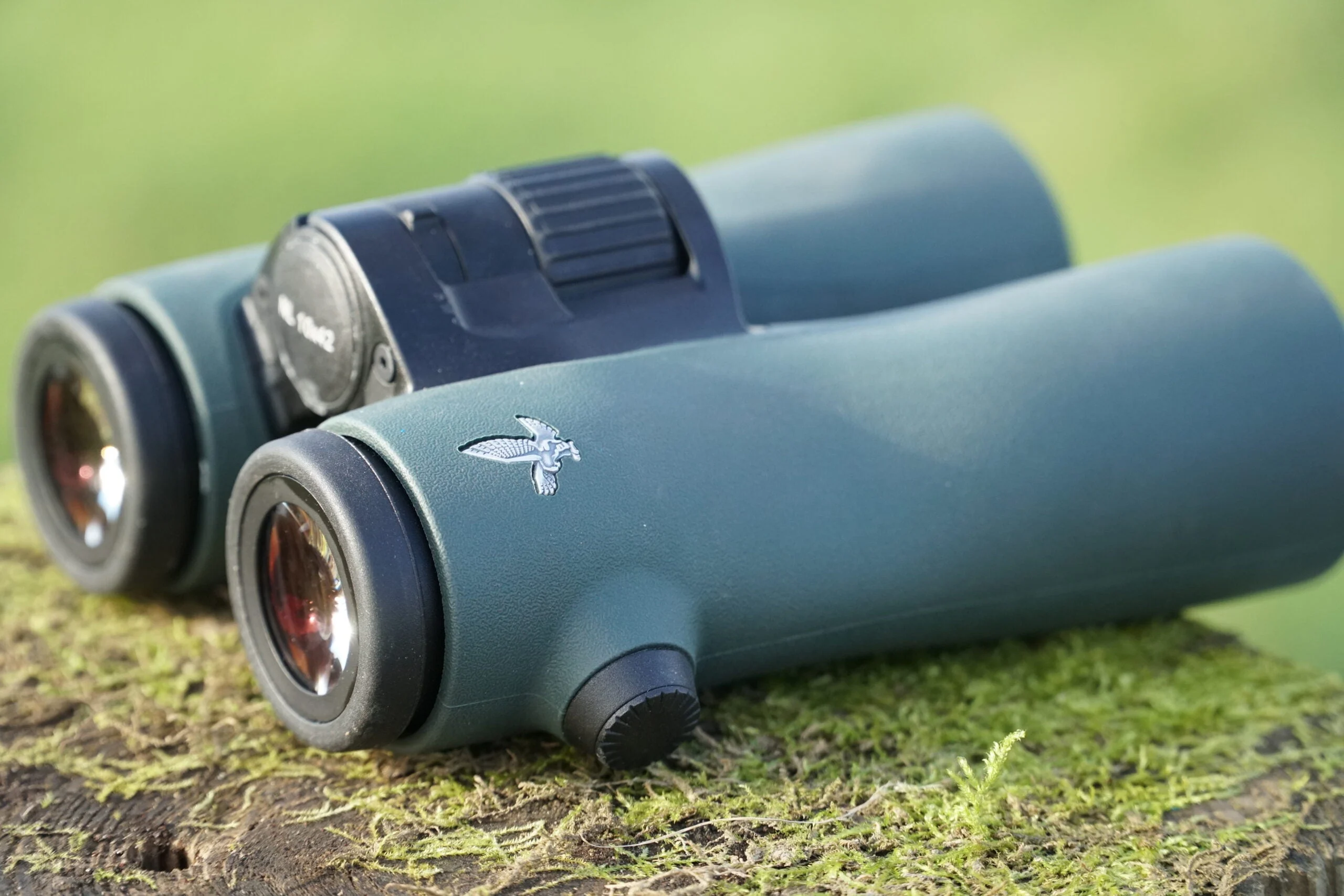
I took the NL Pure 10×42 on an elk and deer hunt in Montana recently. At one point, we were glassing a bedded whitetail buck from long ways off, trying to figure out if he was worth a stalk. I was looking through the NL Pure and a buddy was looking through another $1,000-plus premium binocular. Studying the deer, I said, “He’s got decent mass but isn’t super tall or wide. He might go 130.” My buddy asked how I’d gotten all that from so far away. I handed him the NL Pure, he looked through them, and he said “Holy sh*t!” Then he studied the buck for minute and said, “Yup. Maybe 125.”
That’s what next-level resolution does for you, and it makes a real difference in the field. But world-class glass like this offers more than just stunning detail; it immerses you in the image. An optics professor I used to test binoculars with calls this “feeling of immersion.” With the NL Pure’s huge field of view and field-flattening lenses, you get the sense that you’ve stepped into the picture and that everything there is brilliant and vivid and free of the little imperfections that otherwise distract you from the experience.
The NL Pure’s innovative hour-glass, open-bridge design not only saves weight but balances perfectly in the hand, making it easy to stabilize the binocular on long glassing sessions, and an available forehead rest adds to the comfort. The focus wheel is large, precise, and silky. The diopter and eyecup adjustments are positive and exact.
All of that said, the NL Pure is not flawless. To my surprise, it pretty much bombed the weather-resistance test. After the submersion portion, the image was useable but not especially clear, and it was close to unusable coming out of the deep freeze. Again, our test is tougher than what most hunters will face in the outdoors, but still, in an apples-to-apples comparison, only two binoculars on this list did worse.
That, however—and the price (oof!)—are the NL Pure’s only flaws. In every other way, this binocular is nothing short of spectacular. Give it a little extra protection in the weather, and it will show you things other hunters will never see.
Best for About a Grand: Meopta MeoPro Air 10×42
Why It Made the Cut: It’s not cheap by any means, but in its price category, it’s a standout.
Total Score: 90
Test Model Specs
Magnification: 10x
Objective Lens Diameter: 50mm
Exit Pupil: 5.0 mm
FOV: 360’ @ 1,000 yards
Size: 5.9 x 5.0 inches
Weight: 29.2 ounces
Price: $1,150
Pros
Great image quality
Great low-light performance
Build to last
Solid Value
Cons
Nothing really

If you had $1,000 to spend on a binocular—that is, you wanted something really good but didn’t want to shell out for the absolute best—here’s what I’d tell you: “Find another $150 and get the Meopta Pro Air.” Or, “Wait for this one to go on sale and snap it up.” Had I scored the test categories with letter grades, this binocular would have averaged an A-minus across the board, ranging from quite good to very good in every category and not at all bad in any.
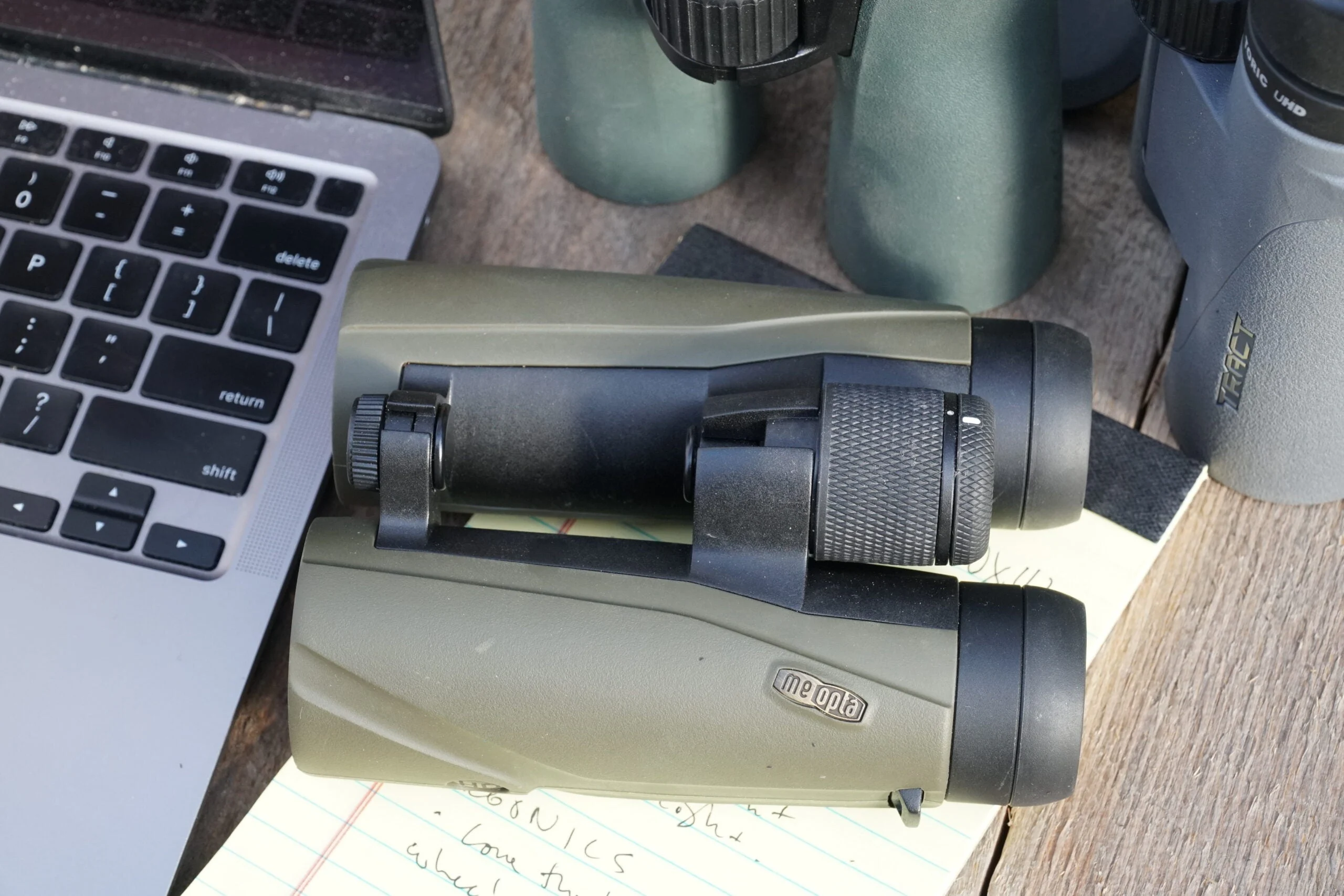
Where the Pro Air did stand out was in image quality, low-light performance, and weather-resistance. Meopta’s Czech glass is just a tiny step below the very best, delivering fine clarity, true, vibrant colors, and a great feeling of immersion, thanks in part to a generous field of view. It sailed through the weather-resistance test, delivering a quite-good image after submersion and a perfectly useful image after being frozen. The rubber-reinforced magnesium body is reasonably lightweight but tough, and the open-bridge design feels good in the hand. The focus wheel on my test model was a tad stiff and the non-locking diopter possibly just loose enough to bump it out of whack on occasion—but this is nit picking. What you have here is a binocular that is just shy of the very best, at a commensurate price.
Best Low-Light: Vortex Razor UHD 10×50
Why It Made the Cut: The Razor is built to handle anything and delivers next-level low-light performance.
Total Score: 89
Test Model Specs
Magnification: 10x
Objective Lens Diameter: 50mm
Exit Pupil: 5.0 mm
FOV: 341’ @ 1,000 yards
Size: 7.6 x 5.9 inches
Weight: 36.5 ounces
Price: $2499
Pros
Excellent image quality
Outstanding low-light performance
Built tough
Excels in any weather conditions
Cons
Comparatively large and heavy
Not cheap
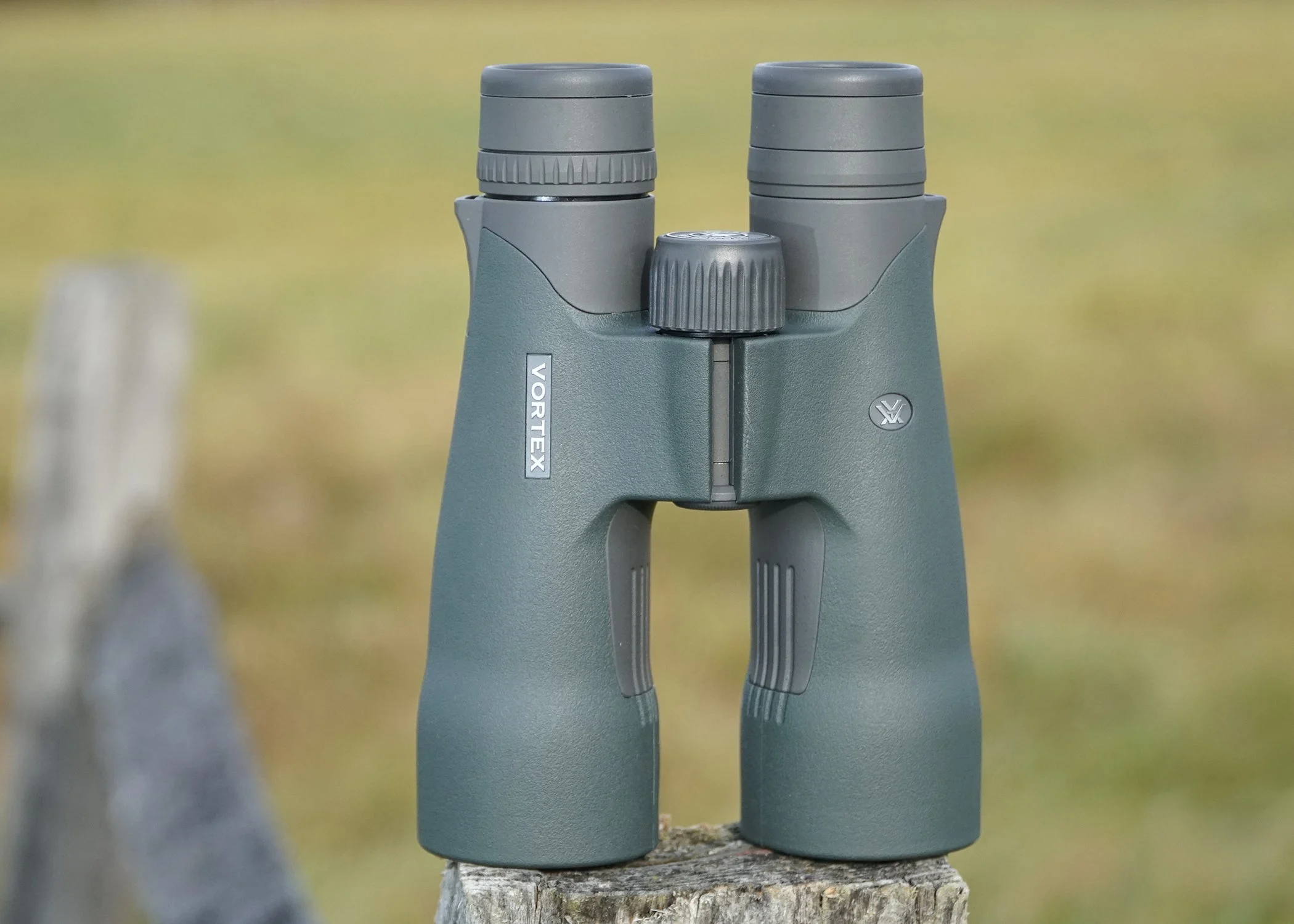
With this upgraded UHD model, Vortex’s premium Razor goes from “High Definition” to “Ultra High Definition”—a distinction that doesn’t always mean much, as these are marketing terms, but in this case boils down to one hell of a good binocular that’s even better than the last iteration. Resolution is quite good, but it’s the image quality and low-light performance that really grab you. The Razor’s clarity, feeling of immersion (the sense that you are stepping into the picture), and lack of visual artifact gave even the top-scoring Swaro a run for its money. And thanks to the comparatively large exit pupil, the Razor notched a perfect low-light score.
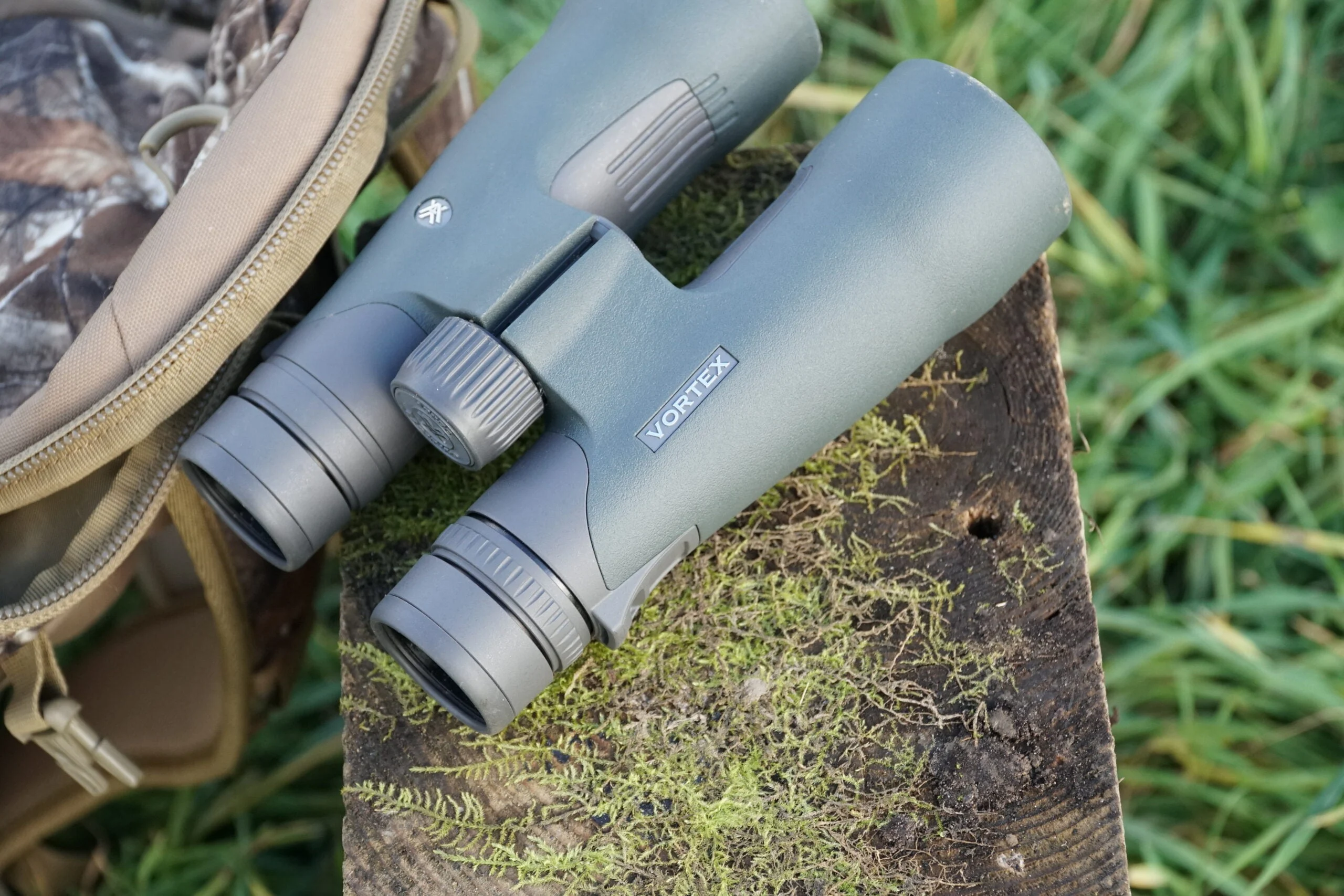
Build quality and ergonomics are also first-rate. The focus wheel is smooth and precise, and the locking diopter adjustment is about perfect. The only categories where the Razor fell down a bit were handling and value. So, let’s take them one at a time. Yes, the Razor is noticeably larger and more than 10 ounces heavier that most models here. But that’s mainly due to the 50mm objective lenses, which contribute heavily to the low-light performance. So, it’s a trade-off. If you want to see right up to the very edge of darkness, the extra size and weight may well be worth it to you. As for value, the MSRP price of $2499 sure isn’t pocket change, but I’ve seen this binocular on sale for well under $2K, which is fair for a premium binocular that’s right there with the very best.
GPO Passion HD 10×42
Why It Made the Cut: The Passion HD finished top-three in the all-important categories of resolution and image quality.
Total Score: 85.5
Test Model Specs
Magnification: 10x
Objective Lens Diameter: 42mm
Exit Pupil: 4.2 mm
FOV: 366’ @ 1,000 yards
Size: 6 x 5.2 inches
Weight: 29.6 ounces
Price: $1,100
Pros
Nice, big field of view
Very good resolution and image quality
Cons
Unlocking the diopter can throw off the focus
A little bigger and heavier than some
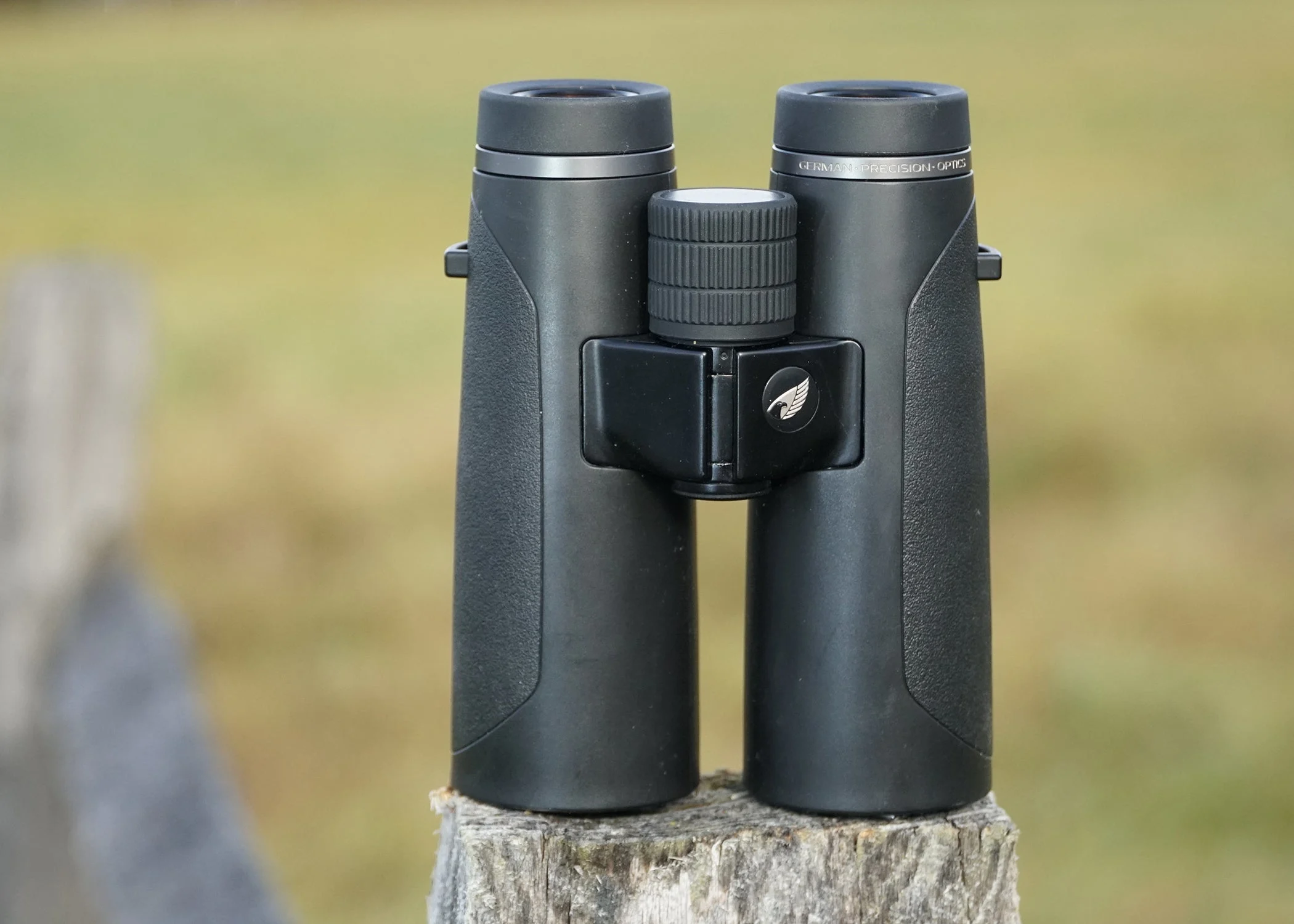
GPO stands for German Precision Optics, which references the fact their scopes and binoculars are designed and engineered at the company headquarters in Germany, while the glass is sourced and the products manufactured primarily in Japan. According to the company, this arrangement has allowed them to offer European-like quality at a better price. The Passion HD has been their flagship binocular for some time and has always done well in our tests, especially in terms of optical performance.
Nothing has changed there. Only three binoculars on this list scored better than the GPO for resolution, and the same is true for image quality. Low-light performance was solid, if not quite great, and if you need a binocular that can deliver a clear image under virtually any conditions, the Passion HD is one, notching a near-perfect score in the weather-resistance test. The Passion HD is clearly well-built, but the diopter is a bit of a problem. I like a locking diopter but to unlock this one, you have to pull the focus wheel itself toward you—the act of which tends to alter the focus. So, after getting the left barrel in perfect focus, I found that unlocking the diopter—no matter how hard I tried to pull the wheel back perfectly straight—threw the left barrel out of focus again. This made getting both barrels into perfect focus a bit of a chore. I got there eventually, and because it’s a locking diopter you shouldn’t have to fiddle with much once it’s set. Still, it’s not ideal, especially if anyone else might be using your binocular.
That said, the Passion HD’s optical performance fits its price tag, and you can find it for closer to $900 if you poke around.
Maven B1.2 10×42
Why It Made the Cut: It’s a great-looking, well-built binocular with solid optics.
Total Score: 84
Test Model Specs
Magnification: 10x
Objective Lens Diameter: 42mm
Exit Pupil: 4.2mm
FOV: 347’ @ 1,000 yards
Size: 5.7 x 5.2 inches
Weight: 26.8 ounces
Price: $1,000
Pros
Very good image quality
Excellent weather-resistance
Great build quality, looks, and ergonomics
Cons
Resolution and low-light performance not quite as good as others in this price range

With the B1.2, Maven has upgraded their popular top-of-the-line B1 by giving it a wider field of view, improved coatings, and a better prism—and they managed to squeeze it all down into a lighter, more compact package, too. The result is a high-quality optic that’s built to last, will perform in the worst weather, feels great in the hand, and looks good, to boot.
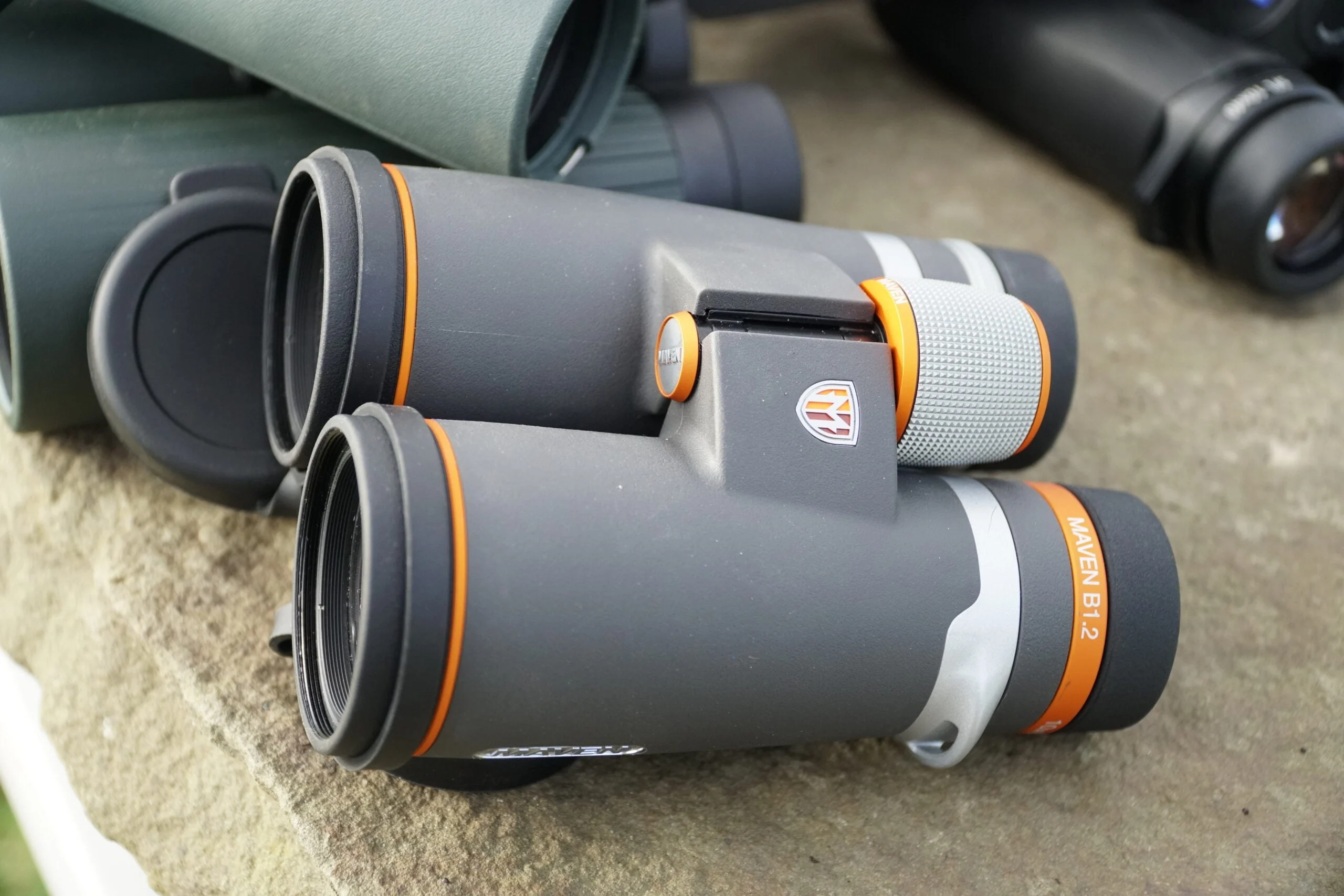
The only dings on the B1.2s came in the resolution and low-light categories, where my test model fell just a bit shy of others in this price range. Image quality, on the other hand, was right there with the top finishers; you get a big, bright, vivid picture with very little blurring at the edges. Maven optics tend to be popular with western mountain hunters where the weather can get brutal, and the B1.2’s performance in my weather-resistance test shows why. They delivered anywhere between a very good image to a perfectly useful image in every phase of the test. The knurled-aluminum finish on the focus wheel (which was a touch balky but precise) and diopter (which has the perfect tension) are nice touches on binocular that doesn’t just look sharp but is also built very tough.
The Maven B1.2 scored just below the GPO Passion mainly because the resolution category is doubled. But if looks and ergonomics are equally important to you, then you should think of the GPO, the Maven, and the Leupold below as very much on par with one another.
Leupold BX-5 Santiam HD 10×42
Why It Made the Cut: The Santiam HD combines solid optics with outstanding ergonomics.
Total Score: 84
Test Model Specs
Magnification: 10x
Objective Lens Diameter: 50mm
Exit Pupil: 5.0 mm
FOV: 341’ @ 1,000 yards
Size: 5.9 x 5.1inches
Weight: 24.3 ounces
Price: $1,000
Pros
Excellent build quality and ergonomics
Compact and lightweight
Feels great in the hand
Extremely weather-resistant
Good low-light performance
Cons
Not the best resolution

Leupold’s top-end binocular, the BX-5 Santiam HD has a similar quality to the Nikon Monarch M7 in that you pick it up and you know it’ll take a beating—that you can hunt hard with it and not worry. This one, though, comes in a somewhat more refined package. The build quality, fit and finish, and ergonomics of the Santiam are first rate. The knurled rubber armoring and open-bridge design combined with the compact size and light weight make for a binocular that feels great in the hand.

There’s a bit of a trade off in resolution, as this binocular didn’t score especially well here compared others in its price range, partly due to some noticeable color shift. But it made up for it with solid scores in image quality and low-light performance and excellent scores in weather -resistance and handling. There was some edge blurring and a bit of tunneling, but the image is bright and vibrant. The focus wheel is about perfect, as is the tension on the non-locking diopter. My general feeling about the Santiam is that I would like it a lot if it cost just a little less. And low and behold, it kind of does. While the MSRP is $1,000, you can find it for closer to $800 if you poke around.
Tract Toric UHD 10×42
Why It Made the Cut: The Toric finished a very close second for our Best Value Award.
Total Score: 84
Test Model Specs
Magnification: 10x
Objective Lens Diameter: 42mm
Exit Pupil: 4.2mm
FOV: 341’ @ 1,000 yards
Size: 6 x 5 inches
Weight: 27.2 ounces
Price: $694
Pros
Solid image quality
Compact and Lightweight
Great rubber armoring
Very weather-resistant
Great value
Cons
Not great resolution
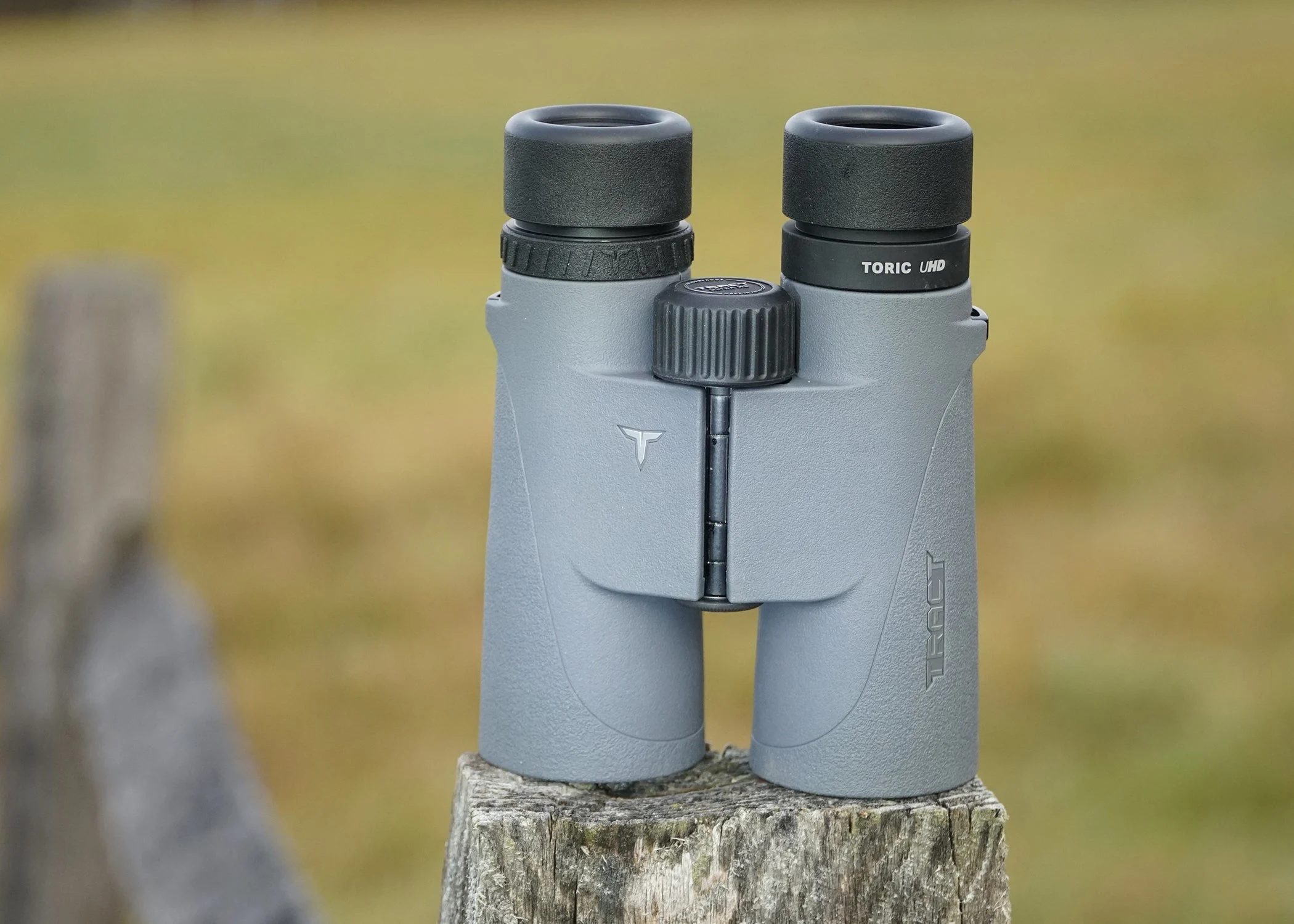
Tract Optics has made a name for itself as a direct-to-consumer brand that offers solid quality for a better price, and their Toric binocular has been a fine example of this for years—and remains so. It’s latest iteration, the UHD Toric has been upgraded with Schott HT extra-low dispersion glass, and the result is a lightweight, compact, full-size binocular that’s built very tough and feels good in the hand, with excellent rubber armoring and nice all-around ergonomics—all at a very fair price.

What about the optics? They are solidly in the good category. My test binocular was middle-of-the-road for resolution, but the image quality and low-light performance was as good or better than some models that cost much more. There is a bit of blurring at the edges of the image and a slight tunneling effect, but both are minor. The Toric aced my very tough weather-resistance test, has an impressively smooth focus wheel, and a good, locking diopter. In the end, if the Nikon Monarch M7 weren’t $150 less expensive, the Toric UHD would have won our Best Value Award. The two are similar in many ways, and while the Nikon has it on resolution, the Toric scored better for low-light performance and, to me, feels a little better in the hand and is sharper looking. You can’t go wrong with either for the price.
Athlon Cronus 15×56
Why It Made the Cut: If it’s fine resolution you’re after, the Cronus delivers—and at a good value.
Total Score: 81.5
Test Model Specs
Magnification: 15x
Objective Lens Diameter: 56mm
Exit Pupil: 5.0 mm
FOV: 235’ @ 1,000 yards
Size: 8.7 x 6.2 inches
Weight: 45.2 ounces
Price: $875
Pros
Excellent resolution
Good value
Cons
Not the best image quality or low-light performance
Poor weather-resistance
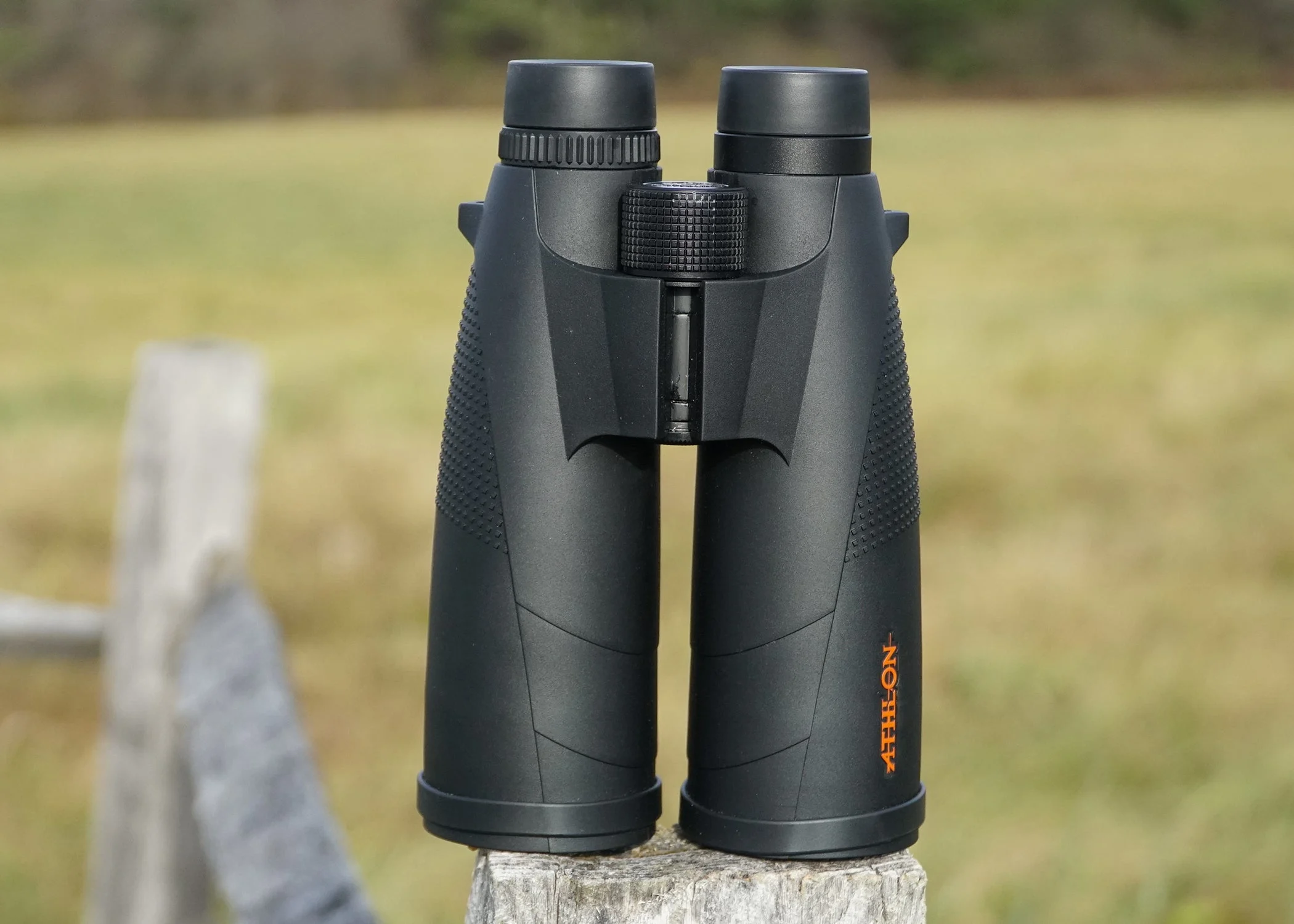
Let me start right off here by saying that it was tough to make a perfect apples-to-apples comparison with this binocular given its size and magnification. While I asked manufacturers to all send 10x models, and the Cronus is available in 10×42, I received a 15×56. I didn’t want to leave them out, so here they are.
In my testing, the Cronus’s image quality and low-light performance was decent but not great. What was great, however, was resolution. (I’ve seen this before, as image quality and resolution are not always tied together. I remember one year when a $200 binocular, that was not very good in any other regard, got a near-perfect score for resolution, besting a couple models that cost 10 times more.) So, if your main goal is to pick out fine details like antler points from long distance, this binocular will do it as well as almost any other on this list. And that is no small thing.
(And no, I didn’t test the 15x Cronus’s resolution at the same distance as the 10x models, in case you’re wondering. I pushed the resolution chart out by a factor of five to level the playing field.)
Obviously, this 15×56 is a lot bigger and heavier than the others here, so I couldn’t really compare it for handling. But as you would probably be buying it as truck binocular, that doesn’t matter much. The Cronus tied with the Vanguard VEO DH IV (see below) for the lowest score for weather resistance, unable to deliver a usable image a half hour after coming out of the freezer. But, again, that’s probably not going to be an issue for a truck binocular.
In the end, while the Cronus didn’t score all that well in my test, I came away feeling like it really fits a certain niche quite well. I know a ton of hunters who want a 15x truck binocular but don’t want to spend a grand-plus. And when you think about what matters most with a truck binocular (resolution) and what doesn’t matter so much (size and weather-resistance), the Cronus fits the bill. Better image quality and low-light performance would be nice, but all things considered, at this magnification, this is a solid value.
Vanguard VEO HD IV 10x42
Why It Made the Cut: The VEO HD IV offers an impressively clear and vivid image for the price.
Total Score: 74
Test Model Specs
Magnification: 10x
Objective Lens Diameter: 42mm
Exit Pupil: 4.2 mm
FOV: 340’ @ 1,000 yards
Size: 5.8 x 5.1 inches
Weight: 27.37 ounces
Price: $500
Pros
Solid image quality
Compact and lightweight
Good ergonomics
Cons
Not great resolution
Not great low-light performance
Poor weather-resistance
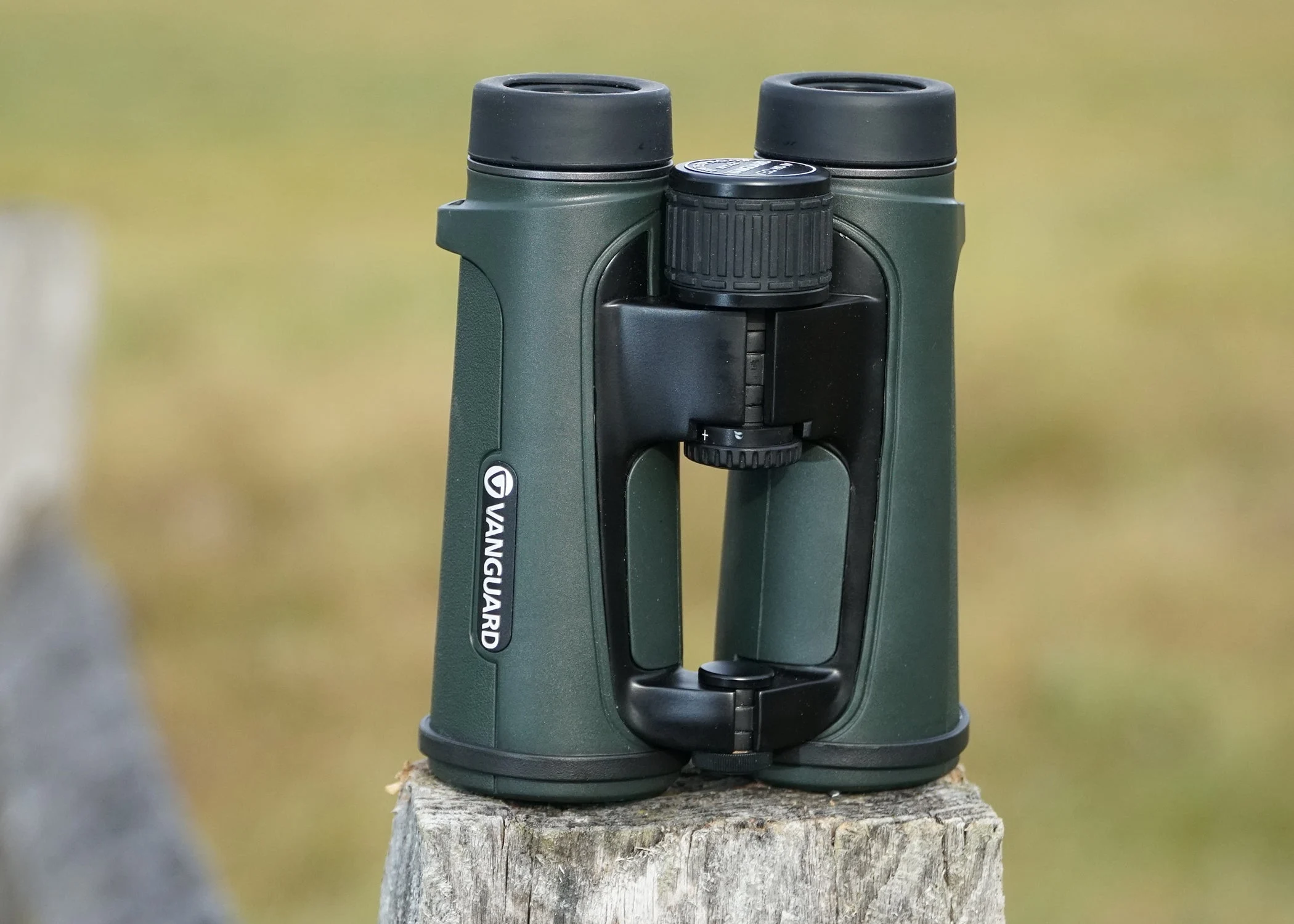
Vanguard’s VEO HD IV is the newest version of their flagship binocular, updraded with HOYA ED glass and a phase-corrected SK-15 prism, combined in part to reduce chromatic aberration. And it worked. The Vanguard binoculars I’ve tested in the past have suffered a bit from noticeable color shift, which is just about absent in the new VEO HD IVs. The binocular delivers an impressively clear and vivid image for the price. It’s also compact and lightweight, and I love the feel of the open-bridge design. My test model wasn’t quite up to snuff compared to the others, however, in the resolution and low-light tests, and it tied for the lowest scores for weather-resistance. The freezer test knocked it nearly out of commission, and it took a full day for the right tube to clear. (It’s worth noting again, here, that my test is more demanding than what nature is apt the throw at most hunters.)
All in all, my sense was that the VEO DH IV punches a little below it’s retail price, but that if you could find it on sale, it’s worth a look, especially if you tend not to hunt in harsh weather.
How We Tested Binoculars

For decades, Field & Stream has been putting hunting glass through rigorous testing to help readers separate the great from the very good and the good from the garbage—and we’re not afraid to tell you which is which. You wont find a tougher, more thorough, or more honest optics test. Binocular manufacturers, to their credit, have always been on board to submit their products for evaluation, and this year was no different. We received a total of 11 models in the full-size category to compare head-to-head.
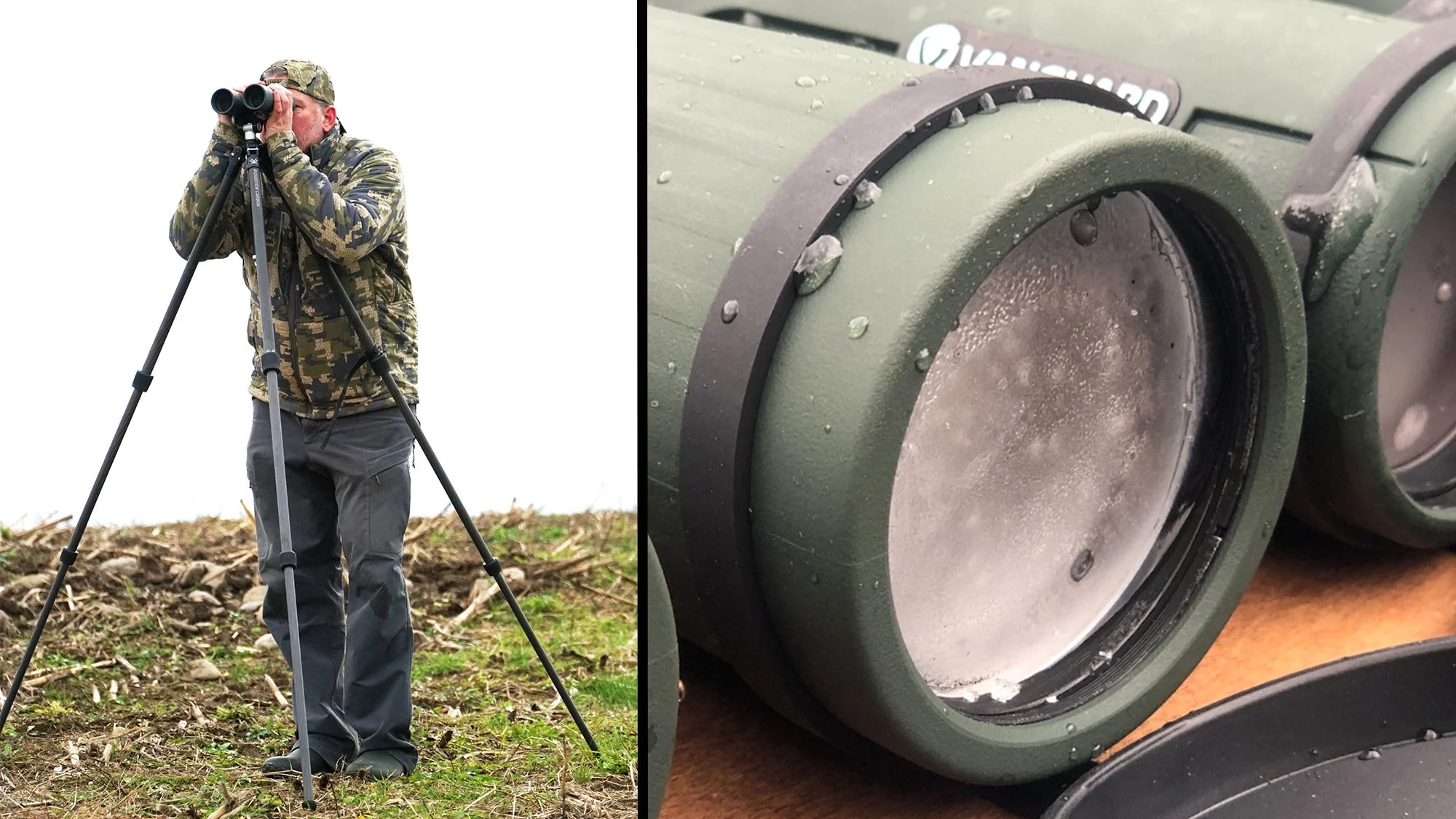
Because binocular manufacturers do not unveil new products every year, I invited optics companies to send their best, most-recent full-size binocular in for testing. Upon their arrival, I checked each model to make sure they met advertised specs, and then I spent weeks on the range and in the field running them through a long list of tests and evaluations to determine how they all stack up.
How We Scored Binoculars
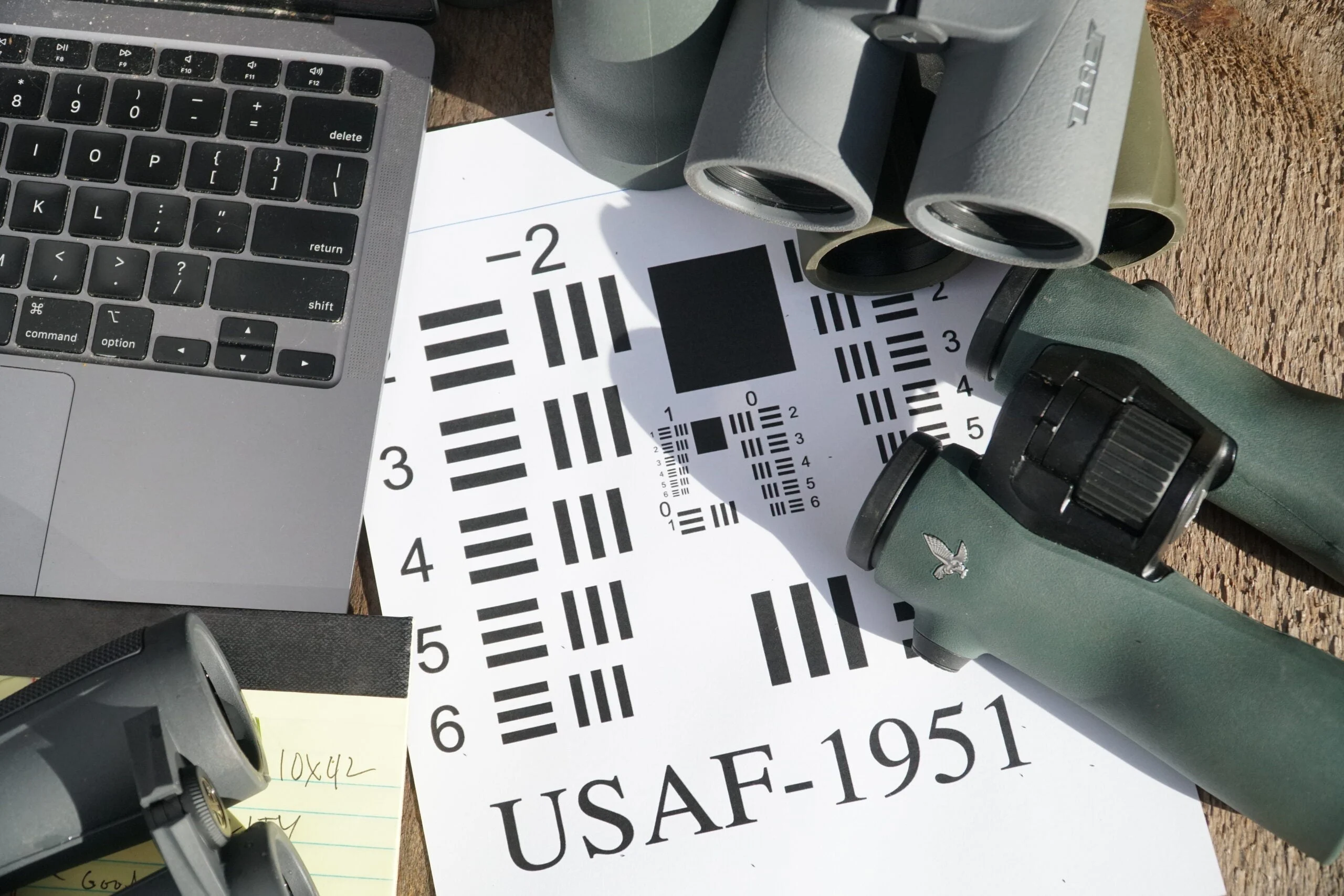
I evaluated each binocular for the following eight categories:
Resolution: I set up a 1951 USAF Resolution Test Chart and a color-artifact test at 50 yards and recorded values for each binocular corresponding to detail resolved and color shift perceived.
Image Quality: In a variety of landscapes and lighting situations, I evaluated each binocular’s image for clarity, feeling of immersion, and visual artifacts, including stray light and apparent field curvature (or blurring at the edges).
Low-Light Performance: This category aggregated exit pupil and low-light resolution, using a 1951 USAF Resolution Test Chart set up in the dark and lit only by a far-way flood light. (Why not at dawn and dusk? Because fading or growing light makes it impossible to compare each on a level playing field.)
Build Quality and Ergonomics: I judged overall feel in the hand, as well as the quality, feel, and functionality of the focus wheel, eyepieces, diopter adjustment, and lens covers.
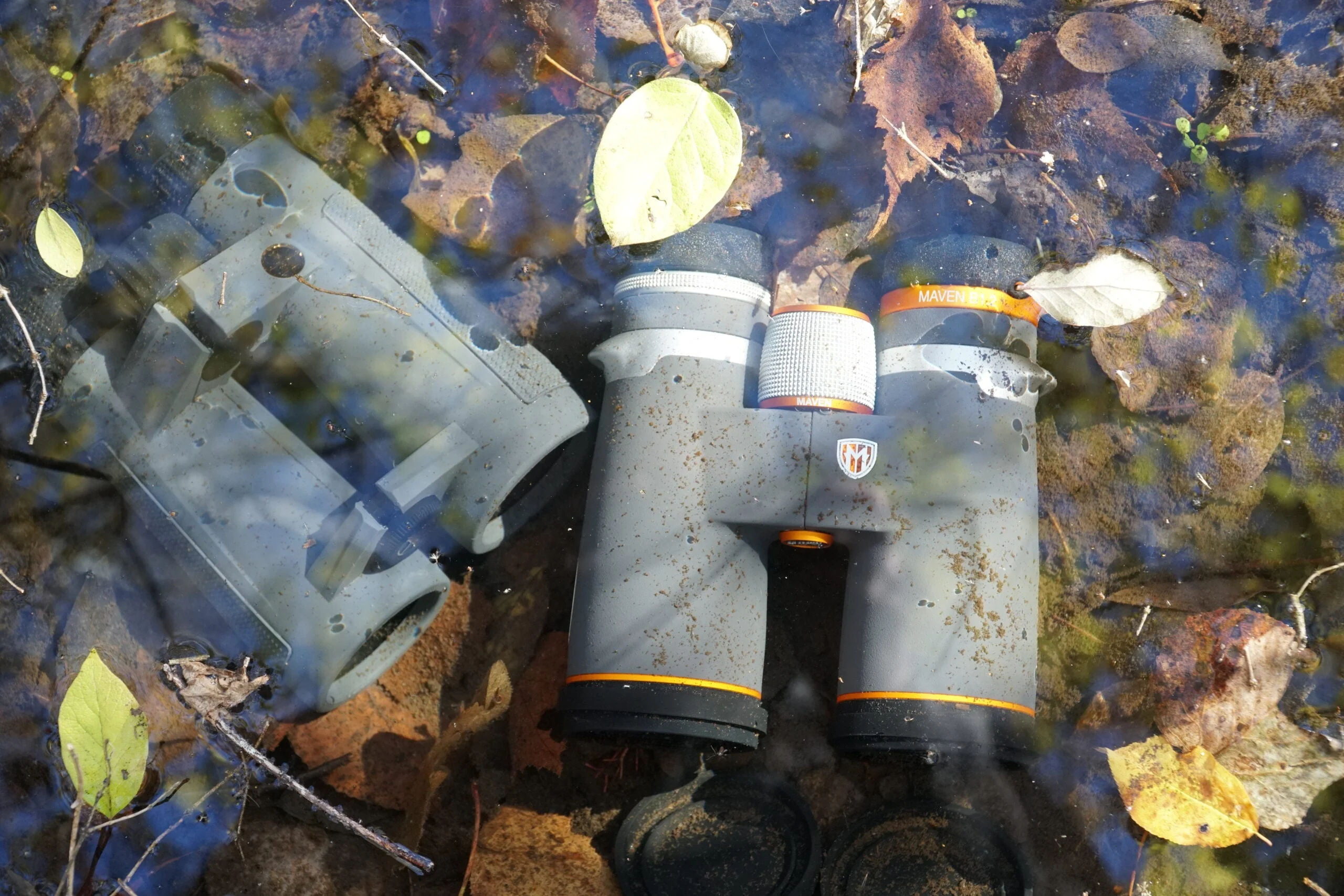
Weather Resistance: I submersed each binocular in a creek next to my house for a half hour, then took them out and scored them for image quality and resolution. Then I put them in a chest freezer for a half hour and rated them on image, resolution, and functionality immediately after and again a half-hour after coming out of the deep freeze.
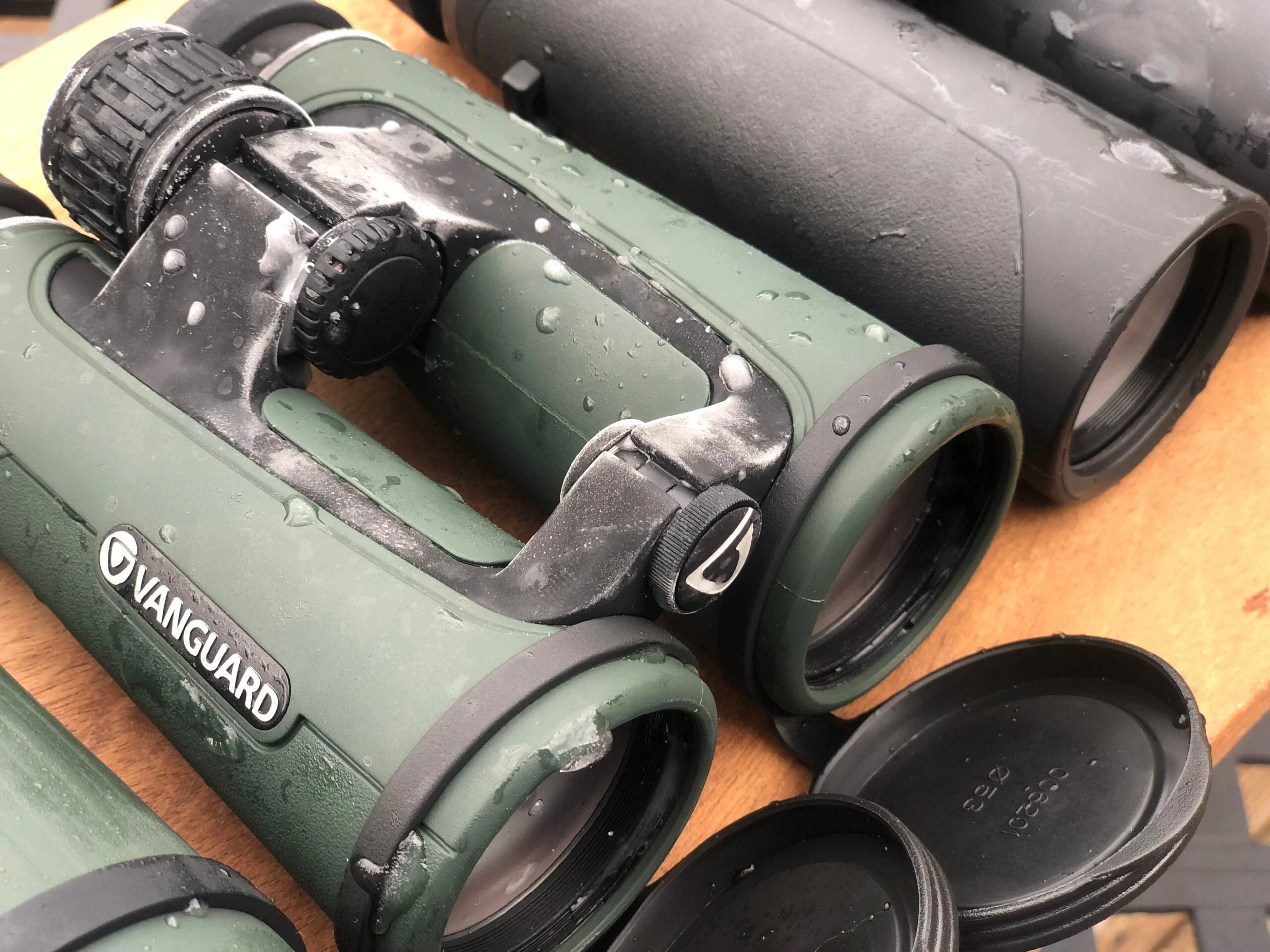
Handling: All else being equal, the lighter and more compact a binocular, the better, which is why this category is a straight reflection of each test model’s size and weight.
Value: Performance divided by price.
I scored each binocular on a 1 to 10 scale for all the categories above and then double the key ones or resolution (because seeing fine detail, like antler points, at distance is a big deal to most hunters), image quality (because it can make extended viewing so much more comfortable and enjoyable), and weather-resistance (because we need our binos to work no matter what), for a total possible score of 100 points.
Why Trust Us
For more than 125 years, Field & Stream has been providing readers with honest and authentic coverage of outdoor gear. Our writers and editors eat, sleep, and breathe the outdoors, and that passion comes through in our product reviews. You can count on F&S to keep you up to date on the best new gear. And when we write about a product—whether it’s a bass lure or a backpack—we cover the good and the bad, so you know exactly what to expect before you decide to make a purchase.

